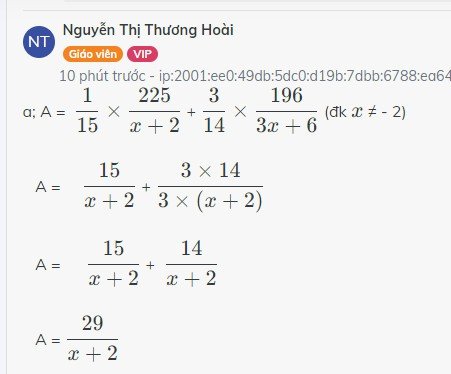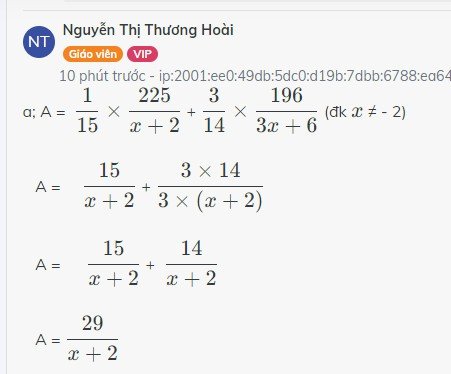Hãy nhập câu hỏi của bạn vào đây, nếu là tài khoản VIP, bạn sẽ được ưu tiên trả lời.

A = \(\dfrac{2x-1}{x+2}\)
a, A là phân số ⇔ \(x\) + 2 # 0 ⇒ \(x\) # -2
b, Để A là một số nguyên thì 2\(x-1\) ⋮ \(x\) + 2
⇒ 2\(x\) + 4 - 5 ⋮ \(x\) + 2
⇒ 2(\(x\) + 2) - 5 ⋮ \(x\) + 2
⇒ 5 ⋮ \(x\) + 2
⇒ \(x\) + 2 \(\in\) { -5; -1; 1; 5}
⇒ \(x\) \(\in\) { -7; -3; -1; 3}
c, A = \(\dfrac{2x-1}{x+2}\)
A = 2 - \(\dfrac{5}{x+2}\)
Với \(x\) \(\in\) Z và \(x\) < -3 ta có
\(x\) + 2 < - 3 + 2 = -1
⇒ \(\dfrac{5}{x+2}\) > \(\dfrac{5}{-1}\) = -5 ⇒ - \(\dfrac{5}{x+2}\)< 5
⇒ 2 - \(\dfrac{5}{x+2}\) < 2 + 5 = 7 ⇒ A < 7 (1)
Với \(x\) > -3; \(x\) # - 2; \(x\in\) Z ⇒ \(x\) ≥ -1 ⇒ \(x\) + 2 ≥ -1 + 2 = 1
\(\dfrac{5}{x+2}\) > 0 ⇒ - \(\dfrac{5}{x+2}\) < 0 ⇒ 2 - \(\dfrac{5}{x+2}\) < 2 (2)
Với \(x=-3\) ⇒ A = 2 - \(\dfrac{5}{-3+2}\) = 7 (3)
Kết hợp (1); (2) và(3) ta có A(max) = 7 ⇔ \(x\) = -3

a; A = \(\dfrac{1}{15}\) \(\times\) \(\dfrac{225}{x+2}\) + \(\dfrac{3}{14}\) \(\times\) \(\dfrac{196}{3x+6}\) (đk \(x\) ≠ - 2)
A = \(\dfrac{15}{x+2}\) + \(\dfrac{3\times14}{3\times\left(x+2\right)}\)
A = \(\dfrac{15}{x+2}\) + \(\dfrac{14}{x+2}\)
A = \(\dfrac{29}{x+2}\)
b; A = \(\dfrac{29}{x+2}\) (-2 ≠ \(x\) \(\in\) Z)
A \(\in\) Z ⇔ 29 ⋮ \(x\) + 2
\(x\) + 2 \(\in\) Ư(29) = {-29; - 1; 1; 29}
Lập bảng ta có:
| \(x\) + 2 | - 29 | - 1 | 1 | 29 |
| \(x\) | -31 | -3 | -1 | 27 |
Theo bảng trên ta có: \(x\) \(\in\) {- 31; -3; -1; 27}
Vậy \(x\) \(\in\) {-31; -3; -1; 27}

a)để A là phân số => x khác 1/2
b) Để A∈∈Z
=> 2x+5⋮2x−12x+5⋮2x−1
ta có : 2x-1⋮⋮2x-1
=>(2x+5)-(2x-1)⋮⋮2x-1
=>6⋮⋮2x-1
=> 2x-1∈∈Ư(6)={±±1;±±2;±±3;±±6}
ta có bảng :
| 2x-1 | 1 | -1 | 2 | -2 | 3 | -3 | 6 | -6 |
| x | 1 | 0 | 3232 | −12−12 | 2 | -1 | 7272 | −52−52 |
Mà A ∈∈Z
Vậy x∈∈{±±1;0;2}
c) ta có :A= 2x−52x−1=2x−1−42x−1=2x−12x−1−42x−1=1−42x−12x−52x−1=2x−1−42x−1=2x−12x−1−42x−1=1−42x−1
để A lớn nhất
=>1−42x−11−42x−1lớn nhất
=> 2x-1<0 và 2x-1 lớn nhất
=> 2x-1=-1
=>2x=0
=>x=0
Vậy tại x =0 thì A đạt giá trị lớn nhất

b) Để M là số nguyên thì \(2n-7⋮n-5\)
\(\Leftrightarrow2n-10+3⋮n-5\)
mà \(2n-10⋮n-5\)
nên \(3⋮n-5\)
\(\Leftrightarrow n-5\inƯ\left(3\right)\)
\(\Leftrightarrow n-5\in\left\{1;-1;3;-3\right\}\)
hay \(n\in\left\{6;4;8;2\right\}\)
Vậy: \(n\in\left\{6;4;8;2\right\}\)
a) Ta có: \(\left|x-3\right|=2x+4\)
\(\Leftrightarrow\left[{}\begin{matrix}x-3=2x+4\left(x\ge3\right)\\x-3=-2x-4\left(x< 3\right)\end{matrix}\right.\)
\(\Leftrightarrow\left[{}\begin{matrix}x-2x=4+3\\x+2x=-4+3\end{matrix}\right.\Leftrightarrow\left[{}\begin{matrix}-x=7\\3x=-1\end{matrix}\right.\)
\(\Leftrightarrow\left[{}\begin{matrix}x=-7\left(loại\right)\\x=-\dfrac{1}{3}\left(nhận\right)\end{matrix}\right.\)
Vậy: \(x=-\dfrac{1}{3}\)

bài 1/
a) ta có: \(A=\frac{15}{x-1}\)
Để A là phân số \(\Rightarrow x-1\ne0\)
\(\Rightarrow x\ne1\)
b) Nếu x = 7
\(\Rightarrow A=\frac{15}{7-1}\)
\(\Rightarrow A=\frac{15}{6}\)
Nếu x = -3
\(\Rightarrow A=\frac{15}{-3-1}\)
\(\Rightarrow A=\frac{15}{-4}\)
Nếu x = 4
\(\Rightarrow A=\frac{15}{4-1}\)
\(\Rightarrow A=\frac{15}{3}=5\)
c) Ta có: \(B=5\)
\(\Leftrightarrow A=\frac{15}{x-1}=5\)
\(\Leftrightarrow x-1=3\)
\(\Leftrightarrow x=4\)
Bài 2/
a) \(\frac{x}{3}=\frac{2}{6}\)
\(\Leftrightarrow6x=6\)
\(\Leftrightarrow x=1\)
b) \(-\frac{x}{14}=\frac{10}{-7}\)
\(\Leftrightarrow7x=140\)
\(\Leftrightarrow x=20\)
hok tốt!!


a) \(A=\frac{6x-1}{3x+2}\left(x\ne\frac{-2}{3}\right)\)
Thay x=4 (tm) vào A ta có: \(A=\frac{6\cdot4-1}{3\cdot4+2}=\frac{23}{14}\)
Thay x=-1(tm) vào A ta có: \(A=\frac{-1\cdot6-1}{3\cdot\left(-1\right)+2}=\frac{-6-1}{-3+2}=\frac{-7}{-1}=7\)
Thay x=0 (tm) ta có: \(A=\frac{6\cdot0-1}{3\cdot0+2}=\frac{-1}{2}\)
Vậy A=\(\frac{23}{14}\)khi x=4; \(A=7\)khi x=-1; A=\(\frac{-1}{2}\)khi x=0
b) A=\(\frac{6x-1}{3x+2}\left(x\ne\frac{-2}{3}\right)\)
Để A là số nguyên thì 6x-1 chia hết cho 3x+2
\(\Leftrightarrow A=\frac{2\left(3x+2\right)-5}{3x+2}=2-\frac{5}{3x+2}\)
Để A nguyên thì \(\frac{5}{3x+2}\)nguyên => 5 chia hết cho 3x+2
Vì x thuộc Z => 3x+2 thuộc Z => 3x+2 thuộc Ư (5)={-5;-1;1;5}
Ta có bảng
Vậy x={-1;1} thì A nguyên